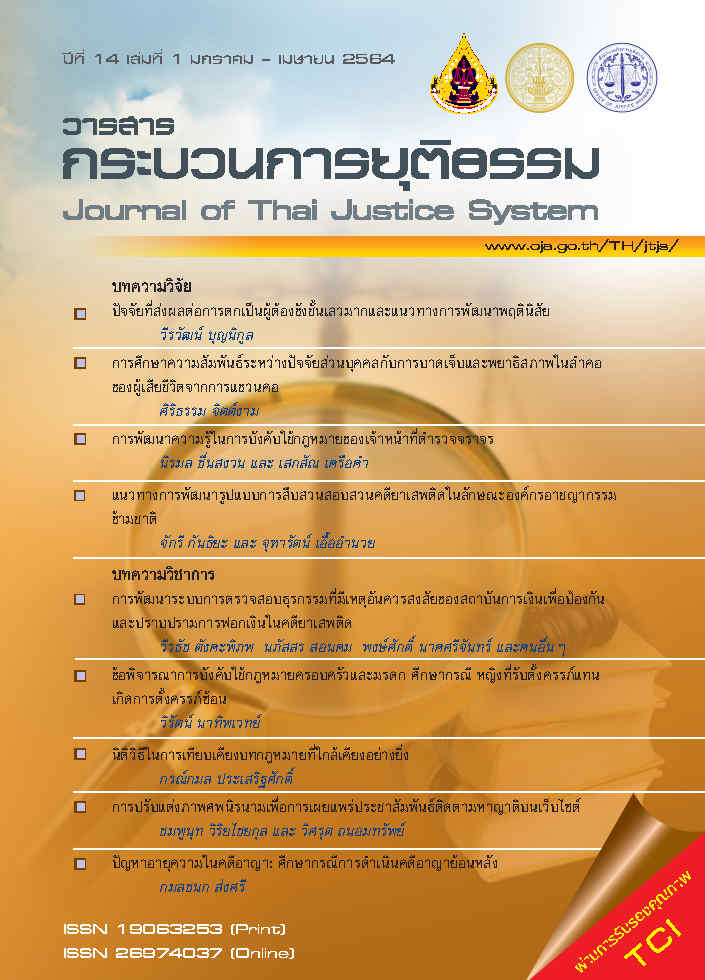นิติวิธีในการเทียบเคียงบทกฎหมายที่ใกล้เคียงอย่างยิ่ง
Main Article Content
บทคัดย่อ
ในการบัญญัติกฎหมายให้ครอบคลุมกับทุกกิจกรรมในสังคมเป็นเรื่องที่ยอมรับกันว่าเป็นไปได้ยากอย่างยิ่ง ในระบบกฎหมาย Civil Law จึงอาจเกิดปัญหาช่องว่างแห่งกฎหมายเมื่อผู้ใช้กฎหมายไม่สามารถแสวงหาบทบัญญัติของกฎหมายลายลักษณ์อักษรมาปรับแก่ข้อเท็จจริงที่เกิดขึ้น ประกอบกับการที่ผู้พิพากษามีหน้าที่ต้องพิพากษาคดี จะปฏิเสธการตัดสินคดีโดยอ้างว่าไม่มีบทบัญญัติแห่งกฎหมายที่จะใช้บังคับแก่คดีหรือว่าบทบัญญัติแห่งกฎหมายที่จะใช้บังคับนั้นเคลือบคลุมหรือไม่บริบูรณ์ไม่ได้ ดังนั้น นิติวิธีในระบบกฎหมายจึงเข้ามามีบทบาทเกื้อหนุนให้ผู้ใช้กฎหมายสามารถปรับใช้กฎหมายและแสวงหาวิถีทางแก้ไขปัญหาที่เกิดขึ้น บทความนี้จึงมุ่งแสดงถึงการใช้นิติวิธีในการเทียบเคียงบทกฎหมายที่ใกล้เคียงอย่างยิ่งเพื่ออุดช่องว่างแห่งกฎหมายในการแก้ไขปัญหาดังกล่าว โดยการศึกษาเริ่มจาก ความหมายของนิติวิธี นิติวิธีในระบบกฎหมาย เพื่อแสดงให้เห็นถึงทัศนคติของนักกฎหมายในมุมมองต่าง ๆ แล้วจึงมาศึกษาถึงนิติวิธีในการเทียบเคียงบทกฎหมายที่ใกล้เคียงอย่างยิ่งในกฎหมายต่างประเทศและในกฎหมายไทย ตลอดจนวิเคราะห์การใช้นิติวิธีในการเทียบเคียงบทกฎหมายที่ใกล้เคียงอย่างยิ่งในความสัมพันธ์กับทัศนคติของผู้ใช้กฎหมายในระบบกฎหมายไทย พร้อมทั้งให้ข้อคิดเห็นที่เกี่ยวข้องกับการศึกษา ซึ่งท้ายที่สุด เมื่อการเทียบเคียงบทกฎหมายที่ใกล้เคียงอย่างยิ่งเป็นนิติวิธีในระบบกฎหมายไทยที่กฎหมายได้วางกลไกไว้ ผู้ใช้กฎหมายจึงสามารถปรับใช้การเทียบเคียงบทกฎหมายที่ใกล้เคียงอย่างยิ่งตามเหตุผลกับความมุ่งหมายของกฎหมายเพื่อนำมาอุดช่องว่างแห่งกฎหมายได้ การศึกษานี้จึงคาดหวังว่าจะเป็นประโยชน์ต่อกระบวนการยุติธรรมของประเทศไทยในการปรับใช้การเทียบเคียงบทกฎหมายที่ใกล้เคียงอย่างยิ่งเพื่ออำนวยความยุติธรรมแก่คดีตามนิติวิธีในระบบกฎหมายต่อไป
Article Details
ต้นฉบับที่ได้รับการตีพิมพ์ในวารสาร เป็นลิขสิทธิ์ของวารสารกระบวนการยุติธรรม แต่ความคิดเห็นที่ปรากฏในเนื้อหาของบทความในวารสารกระบวนการยุติธรรม ถือเป็นความรับผิดชอบของผู้เขียนแต่เพียงผู้เดียว
เอกสารอ้างอิง
กิตติศักดิ์ ปรกติ. (2560). ความเป็นมาและหลักการใช้นิติวิธีในระบบซีวิลลอว์และคอมมอนลอว์ (พิมพ์ครั้งที่ 5). กรุงเทพมหานคร: วิญญูชน.
ปรีดี เกษมทรัพย์. (2526). กฎหมายแพ่ง: หลักทั่วไป (พิมพ์ครั้งที่ 5). ภาพพิมพ์: มหาวิทยาลัยธรรมศาสตร์.
ปรีดี พนมยงค์. (2471). บันทึกข้อความสำคัญประกอบด้วยอุทาหรณ์และคำแนะนำแห่งประมวลกฎหมายแพ่ง และพาณิชย์ บรรพ 1. พระนคร: นิติสาส์น.
มานิตย์ วงศ์เสรี. (2562). นิติวิธี การใช้และการตีความกฎหมาย: ศึกษาเปรียบเทียบระบบกฎหมายไทยและระบบกฎหมายเยอรมัน. กรุงเทพมหานคร: วิญญูชน.
ศนันท์กรณ์ โสตถิพันธุ์. (2562). คำอธิบายหลักพื้นฐานของกฎหมายเอกชน. กรุงเทพมหานคร: วิญญูชน.
สมยศ เชื้อไทย. (2562). คำอธิบายวิชากฎหมายแพ่ง: หลักทั่วไป (พิมพ์ครั้งที่ 26). กรุงเทพมหานคร: วิญญูชน.
โสภณ รัตนากร. (2558). ระบบกฎหมายไทยเป็นระบบซีวิลลอว์หรือคอมมอนลอว์. ดุลพาห, 62(2), 1-11.
หยุด แสงอุทัย. (2552). ช่องว่างแห่งกฎหมาย (พิมพ์ครั้งที่ 2). กรุงเทพมหานคร: วิญญูชน.
หนังสือต่างประเทศ
Barak, A., & Bashi, S. (2005). Purposive interpretation in law. Oxford: Princeton University Press.
Cheng, B. (1994). General principles of law as applied by international courts and tribunals (3 ed.) London: Cambridge University Press.
Foster, N., & Sule, S. (2002). German legal system and laws (3 ed.). The United States: Oxford University Press.
Hadfield, G. K. (2007). The quality of law in civil code and common law regimes: Judicial incentives,lLegal human capital and the evolution of law. Retrieved February 20, 2020, from https://papers.ssrn.com/sol3/papers.cfm?abstract_id=967494
Irti, C. (2014). The problem of legal gaps. Tulane European & Civil Law Forum, 29, 157-179.
Langenbucher, K. (1998). Argument by analogy in European law. Cambridge Law Journal, 57(3), 481-521.
Merryman, J. H. (1966). The Italian style III: Interpretation. Stanford Law Review, 18(4), 583-611.


